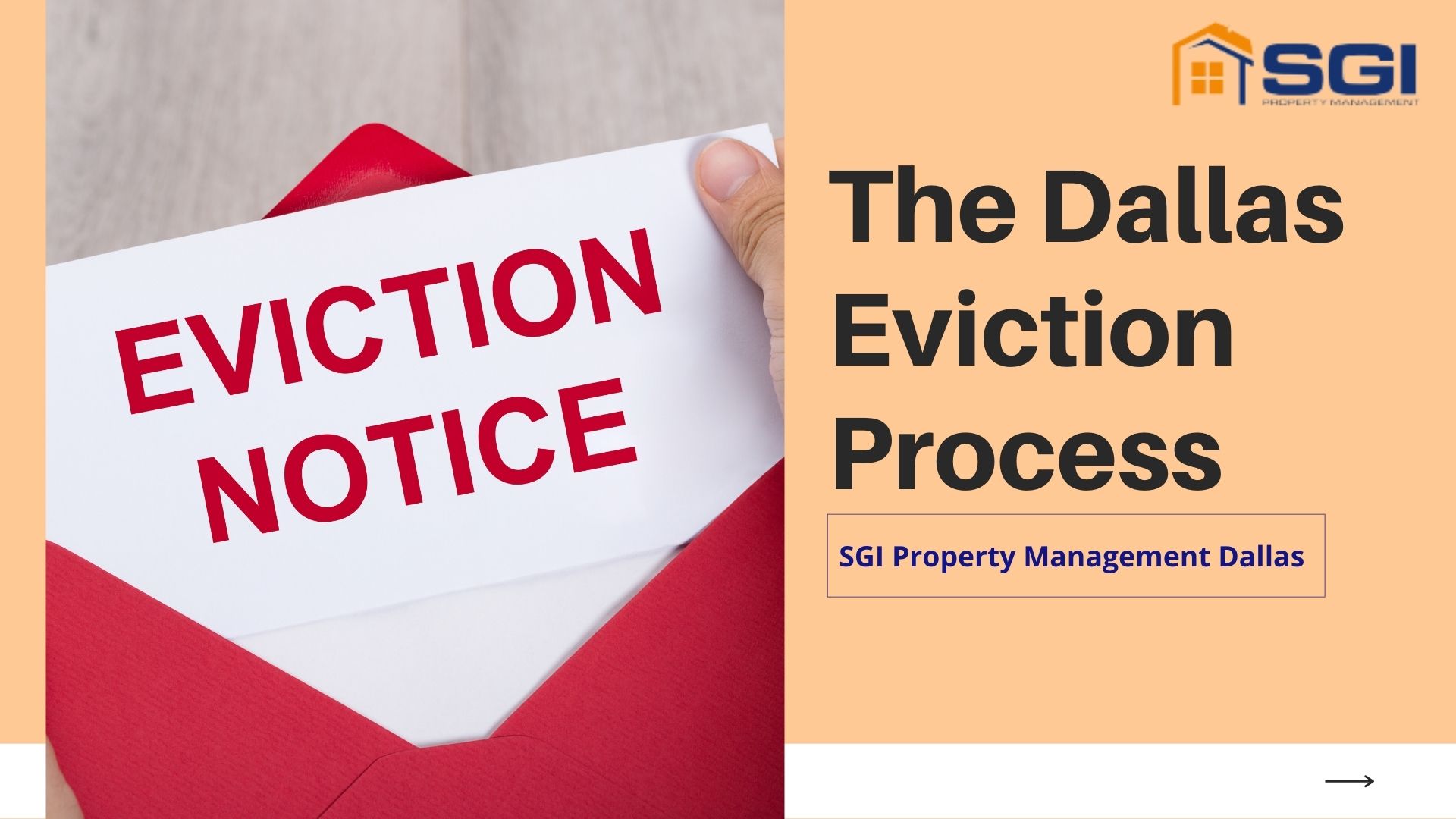
Dallas Eviction Process: What You Need to Know
If you are a Dallas, Texas landlord who is dealing with a problem tenant and the road inevitably leads to evictions, you may be asking yourself a variety of questions like:
- “When can I evict a tenant from my rental property?”
- “What are the eviction policies for a sick renter?”
- “Does a landlord have to serve a 21-day notice to vacate?"
- “How long is the eviction process in Texas?”
Now, without a proper understanding of the Dallas, Texas eviction laws, tenant evictions can be anything but easy for a landlord. It can become stressful, costly, and time-consuming.

What are some common reasons for tenant evictions in Dallas?
- Nonpayment of rent
- Property damage exceeding normal wear and tear
- Failure by the Texas tenant to move out when lease agreements end
- Disturbing the peace of fellow neighbors
- Other lease violations
A Dallas landlord must follow the due process of the Texas law when evicting tenants.
For example, you can’t get rid of your renter by using “self-help” means. This means locking the tenant out, moving their belongings out of the unit, or even threatening them to leave is illegal and might land you in hot water with the Dallas eviction court.
In such an eviction case, the Dallas, eviction court would probably rule that you have “constructively” evicted your Texas tenant. This can result in heavy penalties for landlords.
If you are just starting out as a Dallas landlord or are looking to learn more about local or federal rules related to the eviction process in Texas, here is the basic overview of the Dallas and Dallas county eviction process procedure for landlords.
Basic Overview of the Dallas Eviction Process
Step 1: Serving the Notice
Before evicting a tenant, a landlord must have a reason for doing so, like nonpayment or other lease violations. An eviction differs from a renter wanting to terminate a written lease agreement. Once there is a cause, you must serve the renter an eviction notice to inform them they are facing eviction.
This written notice must state the reason for the eviction, as well as the ways to remedy it – if any. The notice requirements are listed below.
- Nonpayment of Rent: If the tenant has not made rental payments, you must serve the renter a 3-Days’ Notice to Pay Rent or Quit. This will give the tenant 3 days to either move out or pay (all of it that's due). Failure by the tenant to take either option, you can move to court and file an eviction lawsuit.
- Lease Violation: Examples of common rental agreement violations include causing rental unit damage and making illegal alterations to the rental property. In any of these cases, you can serve the renter with a 3-Days’ Notice to Vacate. Unlike some other states, when a tenant violates a lease in Texas, you don’t have to give them an option to fix the lease violation. If the renter fails to abide by the notice to vacate, you can take the case to a Dallas eviction court and obtain a forcible detainer suit.
- Holdover Tenants: A holdover tenant are those that refuse to move out once their lease has ended. For a holdover tenant, the period depends on the type of tenancy and lease agreement. For a month to month tenancy, you must serve them one month’s notice to vacate. For week-week tenants, you must serve them a one-week notice to vacate. These tenants are a big issue for landlords, as it prevents renting to other tenants who will follow the agreement.
If a tenant fails to move out on the date written, you can proceed with the eviction suit.

Step #2: Filing and Service of the Complaint
Under state law, once you have served the notice, the next step you have to do is start the eviction lawsuit by filing and serving a complaint at a Dallas eviction court. The complaint filing fees are about $46 at the Justice of the Peace Court.
The serving of the complaint is usually done by a constable or the sheriff. Complaints can be served in the following ways:
- Via regular, certified, or registered mail.
- In-person by affixing the notice in a conspicuous place. For example, on the inside of the main door.
- In-person to the renter or to someone in the household aged at least 16 years.
Step #3: Hearing & Judgment
Once the renter is served the eviction lawsuit, the Dallas eviction hearing will usually take place no more than 21 days later. After filing, and during the eviction hearing, a court judge will grant both you and the tenant an opportunity to present your cases.
If the evicted tenant chooses not to show up on the date of the lawsuit hearing, the judge will rule in your favor by default judgment.
But if they do and the tenant disagrees with the eviction proceedings they may claim that:
The Texas eviction is an act of discrimination.
The Texas Fair Housing rules prohibit landlord discrimination against a tenant based on any of the protected classes. The state’s protected classes include race, color, sex, religion, national origin, familial status, and disability.
The eviction is a retaliatory act.
Harassing or intimidating a tenant because they exercised one of their rights is illegal.
They are justified in not paying rent.
Landlord-tenant law allows tenants to withhold rent or exercise their right to “repair and deduct” if a landlord fails to take care of important repairs. They can do this by getting a repair order from a justice court.
So, as a landlord, you must not evict a tenant who has refused to pay rent due to your unresponsiveness to maintenance requests or repairing property damages to abide with Texas property code.
You tried to evict the tenant using “self-help” tactics.
A landlord may only evict a renter through allowable, legal means outlined in Texas law. Examples of “self-help” tactics include turning off heat or electricity, changing the locks, forcible entry, or taking the tenant’s belongings.
The tenant didn’t violate the lease as alleged.
Obviously, for your Dallas eviction to hold up, you must be able to show proof that the rental agreement was violated. If you can’t, the judge will rule against you.
The eviction notice had errors.
When evicting a tenant, you must prepare a tenant notice in accordance with very specific rules and guidelines. Typically, the Dallas county eviction notice should include important information such as the reason for the eviction, and the amount of time the tenant has to move out or fix the violation.
It must also be a written notice. If the landlord’s notice doesn’t contain any of these things, the eviction proceedings may be delayed.

Step #4: Issuance of the Writ of Possession
If the county court rules that the landlord wins, the court will grant the landlord a Writ of Possession. The Writ of Possession will be the tenant’s final notice to move out on their own.
If they don’t vacate the property, a constable or a sheriff will be mandated to forcibly remove them from the rented premises.
Step #5: Removal of the Tenant
Once the Writ of Possession is posted on the premises, the tenant will have no more than 24 hours to move out. The constable or sheriff will then issue the tenant a 24-hour notice before removing the tenant’s belongings and evicting the tenant.
The Bottom Line
If you are wondering about additional details of how to evict a tenant in Dallas County, be sure to check over the landlord-tenant laws of your area. If you still need assistance, contact a lawyer or a professional property management company in Texas.
Need help removing a problem tenant? If so, SGI Property Management Dallas can help! Our property managers are experienced and knowledgeable of landlord-tenant laws. In addition to assisting you in the Dallas eviction procedure, we can also help find a good tenant for you, as we have for many other Dallas landlords.
Disclaimer: This post is only intended to be informational. For professional, legal advice and more legal information, please seek legal services from a knowledgeable Texas attorney.









